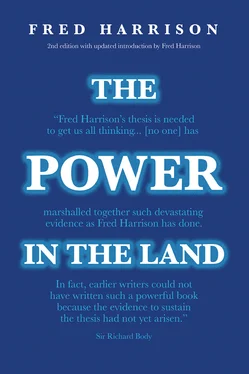1 ...6 7 8 10 11 12 ...21 18 Ibid., pp. 74-75.
19There is one partial exception to this. Where people have borrowed money to speculate in land, the cost of servicing loans during a recession causes some of them to sell at a loss. But the overall effect is the same, for the new owners, buying at attractive prices, then proceed to sit on the land until they reap the speculative profits which were being sought by the previous owners.
20 Op. cit., pp. 370-371.
21 Ibid., p.370.
22 Ibid., p.372.
23A survey in Liverpool in 1773 revealed that 412 of the 6,340 houses were empty, which could not have been the result of a surplus stock : there were 8,000 families resident in the city, which meant that about 2,000 families had to share their homes with others. Rents were calculated to be high — ‘very few can be supposed to let under £5’, according to J. Aiken, A Description of the Country from Thirty to Forty Miles round Manchester, London, 1795, pp. 343, 374.
24 Op. cit., p. 350.
25‘The landlord will allow nobody else to work them without paying some rent, and nobody can afford to pay any.’ Ibid., p. 184.
26 Ibid., p.252.
27 Ibid., p.253.
28 Ibid., p.73.
29Mingay comments on this period: ‘Prudence was the counsel that prevailed... in fiscal matters. The protection of property was the overriding consideration, and no-one knew where economical reform might end — after all, a reassment of the land tax, by now a very modest burden, might prove to be its unforeseen and disastrous consequence’. G. E. Mingay, English Landed Society in the Eighteenth Century, London: Routledge & Kegan Paul, 1963, p.262.
30D. Ricardo, Principles of Political Economy and Taxation (1817), in The Works of David Ricardo, London: John Murray, 1888, p. 121.
31For a critique of his recantation on the land tax issue, which he had delineated in Social Statics (1850), see H. George, A Perplexed Philosopher (1892), New York: Robert Schalkenbach Foundation, 1946.
32J. L. and B. Hammond, The Skilled Labourer 1760-1832, London: Longmans, Green & Co., 1933, p. 115.
3 Monopoly and the Veil of Secrecy
Conspiracy theories are an unattractive way of attacking the enemy. They generally serve as short-cuts across the gaps of ignorance, substitutes for the painstaking process of accumulating and evaluating evidence for submission to the court of public opinion. And they often conceal a certain timidity, for the loose allegations — splattered over a wide area, not hitting the bull’s eye of a sharply-defined target — deny the accused the right to challenge concrete charges and then retaliate against the accusers.
We do, here, identify a grand conspiracy, in the belief that the evidence is forthcoming to substantiate the charges. The specific allegations are that land monopolists, since the Industrial Revolution, have systematically prevented the public from undertaking those inventories that would lift the veil of secrecy that shrouds the land market; that their success arises from the monopolistic structure of the land market; that this has been the greatest antisocial conspiracy in modern history; and that monopolists have been motivated by the knowledge that, paradoxically, government interference — through the fiscal system — is a pre-condition for the creation of freedom and competition in the land market.
A key defining characteristic of capitalism is rationality — the need for long range planning, adaptation of means to ends, and for exact calculation. This specifies the need for information. ‘Underlying the planning and its execution are the evaluation and registration of all business facts in precise quantitative terms and the co-ordination of these records as a significant whole.’ 1 Thus, through the ledgers laboriously compiled by the book-keepers, the individual entrepreneurs could monitor their performance in relation to their attempts to service their consumers. The records exposed their behaviour to themselves and to their competitors, either directly (through access to the balance sheet) or indirectly (through the prices that they charged based on production costs). No such informative facility was available to chronicle the land market.
Compared to the availability of data and institutions which enable us to talk intelligibly about the ‘labour market’ or the ‘capital market’, there is no land market. There are no regularly-published indices of land prices equivalent to the Dow-Jones Industrial Average or the Financial Times Ordinary Share Index. The paucity of information on land is a scandal, for it entails a serious limitation on the economic system to operate at an optimum level of efficiency. One scholar, Colin Clark, notes that ‘land use and land values now constitute one of the most important questions in the world, but the amount of research effort devoted to them is deplorably small’. 2
The industrial economy was forced to establish itself without the aid of a centralised institution dealing in land comparable to the London Stock Exchange, 3 where it was possible to find out what was being sold, and at what prices. A notable attempt to create a recognisable land market was made in 1857. A group of London auctioneers established the Estate Exchange in an effort to bring buyers and sellers together, facilitating the efficient use of land within the UK on the basis of the fullest possible dissemination of information. 4 The attempt failed, but the fact that it was made (it had been proposed in 1838) says something about the needs of the economy. 5 More recently, the American Real Estate Exchange was established in San Francisco in 1969. By 1981, it had nearly $7.5bn. in properties on its sales list, double the value of the previous year and an indication that even monopolists will use such outlets when the depressed state of the economy begins to affect them, but on a typical morning, only 75 real estate people and eight traders were found to be dealing on the floor of the exchange. 6
The absence of an integrated economy-wide land market resulted from the very nature of monopoly power. Labour and capital spontaneously create their factor markets in the course of competing within themselves and with each other for the opportunities to earn income from the creation of new wealth. Land remains largely aloof from this competitive process. As a result, such markets as have developed are localised and depend on the intimate knowledge of real estate agents and advertisements in local newspapers. This places buyers at a severe disadvantage, for their imperfect knowledge about what is happening elsewhere in the economy means that they are ill-equipped to make rational judgments on the ‘best buys’.
Despite the monopoly power and the severe imperfections of knowledge entailed in land transactions, economic theorists persist in describing the rent of land as arising from the interplay of supply and demand as these concepts are understood in their classical sense. This account is inconsistent with the facts. According to the theory of perfect competition, landowners play a submissive role: they accept the ‘left-overs’ from economic activity. That is, they exact what remains over and above that part of fresh output which is necessary to attract labour and capital into the productive process. In this sense, economic rent is a surplus; it becomes a correct measure of the differential contributions of specific plots of land arising from varying fertility or the advantages accruing to favourable locations.
But this model cannot function once monopoly power is introduced. For material welfare can be optimised by the entrepreneur only if he can calculate the correct inputs of land, labour and capital on the basis of their true relative costs. Land monopolists inhibit these calculations to a frightening degree. The proof is presented in the following chapters. Meanwhile, we anticipate the evidence and elaborate what we consider to be the ideal solution, to provide readers with a touchstone against which to judge the workings of the most imperfectly understood element of the industrial economy, namely, the land market.
Читать дальше












